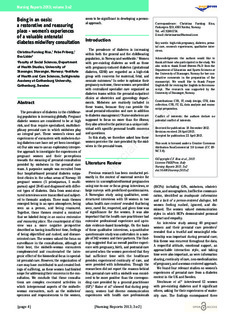| dc.description.abstract | The prevalence of diabetes in the childbearing population is increasing globally. Pregnant diabetic women are considered to be at high risk, and thus require specialized, multidisciplinary prenatal care in which midwives play an integral part. These women’s views and experiences of encounters with midwives during diabetes care have not yet been investigated. Our aim was to use an exploratory interpretive approach to investigate the experiences of pregnant women and their perceptions towards the meaning of prenatal consultation provided by midwives in the prenatal care team. A purposive sample was recruited from four hospital-based prenatal diabetes outpatient clinics in the urban areas of Norway: 10 pregnant women (5 primiparous, 5 multiparous) aged 28-45 and diagnosed with different types of diabetes. Data from semi-structured interviews were transcribed and subjected to thematic analysis. Three main themes emerged: being in an open atmosphere, being seen as a person, and being reassured. Together, these themes created a construct that we labeled being in an oasis-a restorative and reassuring place. The counterpoint of this view was a more negative perspective described as having insufficient time, feelings of being objectified and rushed, and diseaseoriented care. The women valued the focus on surveillance in the consultations, although at their best, the midwife-woman encounters complemented and counteracted the iatrogenic effect of the biomedical focus in specialist prenatal care. However, the organization of care may have contributed to and created feelings of suffering, as these women had limited scope for addressing their concerns in the consultation. We conclude that these consultations are complex co-created activities in which interpersonal aspects of the midwifewoman encounters, such as the midwives’ openness and responsiveness to the women, seem to be significant in developing a personal approach. Introduction The prevalence of diabetes is increasing within both the general and the childbearing population, in Norway and worldwide.1 Women with pre-existing diabetes as well as those with pregnancy-induced diabetes (gestational diabetes, GDM) are regarded as a high-risk group with concerns for maternal, fetal, and neonate outcomes.2 In order to optimize their pregnancy outcome, these women are provided with centralized specialist care organized as diabetes teams within the prenatal outpatient clinics at obstetrics and gynecology departments. Midwives are routinely included in these teams, because they can provide the usual prenatal education and care in addition to diabetes management.3 Nurse-midwives are supposed to focus on more than the illness; they also attend to the patient as a unique individual with specific personal health concerns and questions. In this study, we therefore asked how these women perceive the care provided by the midwives in the prenatal team. | nb_NO |

